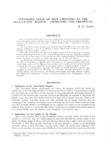Rice is the predominant food and source of employment and income for most of the people in the developing world. It provides about three-fourths of the calories and about one-third to one-half of the protein for the more than 2 billion people in Asia - about half of the world population.
The Asia-Pacific Region produces and consumes more than 90% of the world rice, hence adequate production of rice in the Region is closely linked with the Region's food, socioeconomic and agro-ecological security.
Rice paddy production in the Asia-Pacific Region during 1975-85 increased at an average annual compound growth rate of 3.3% whereas the demand for rice grew annually by slightly more than 3%, of which about 2.1% per annum was due to population growth. During the same period, the gross area under rice paddy increased only by 0.2% per annum.
Considering that the demand for rice during the next decade or so is expected to grow at the trend level and there is negligible scope for expansion of net cultivated area in most of the rice-growing countries of the Region, future increase in rice production must accrue through increased per unit area production by increasing yield or cropping intensity or both.
Problems of intensification, especially soil health and disease and pest incidences, and strategies for and prospects of alleviating the constraints through development of highyielding, disease and pest-resistant, cold-tolerant, period-bound and widely adapted varieties and appropriate management practices, including Integrated Pest Management, will be discussed.

